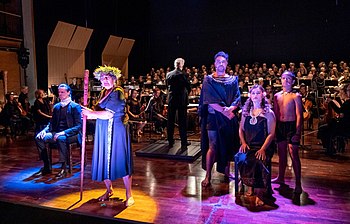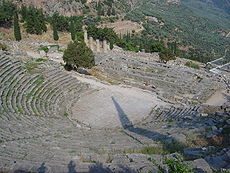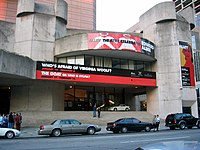Theater (structure)
This article needs additional citations for verification. (March 2013) |
A theater, or playhouse, is a structure where theatrical works, performing arts, and musical concerts are presented. The theater building serves to define the performance and audience spaces. The facility usually is organized to provide support areas for performers, the technical crew and the audience members, as well as the stage where the performance takes place.
There are as many types of theaters as there are types of performance. Theaters may be built specifically for certain types of productions, they may serve for more general performance needs or they may be adapted or converted for use as a theater. They may range from open-air
Elements of a theater building


A theater building or structure contains spaces for an event or performance to take place, usually called the stage, and also spaces for the audience, theater staff, performers and crew before and after the event.[1]
There are usually two main entrances of a theater building. One is at the front, used by the audience, and leads into a foyer and ticketing. The second is called the stage door, and it is accessible from backstage. This is where the cast and crew enter and exit the theater, and there is a tradition called "stage dooring" that some fans participate in, in which fans wait outside of the stage door after the show in hopes of getting an autograph from the actors.
Stage
The acting or performance space is the stage. In some theaters, such as proscenium theaters, arena theaters and amphitheaters, this area is permanent part of the structure. In some theaters the stage area can be changed and adapted specifically to a production, often called a black box theater, due to the common practice of the walls being painted black and hung with black drapes.[1]
Backstage and offstage
Usually in a building used specifically for performance there are offstage spaces used by the performers and crew. This is where
Often a theater will incorporate other spaces intended for the performers and other personnel. A booth facing the stage may be incorporated into the house where
Seating and audience

All theaters provide a space for an audience. In a fixed seating theatre the audience is often separated from the performers by the proscenium arch. In
The seating areas can include some or all of the following:
- Stalls or arena (in North America, "orchestra"): the lower flat area, usually below or at the same level as the stage. The word parterre (occasionally, parquet) is sometimes used to refer to a particular subset of this area. In North American usage this is usually the rear seating block beneath the gallery (see below) whereas in Britain it can mean either the area in front near the orchestra pit, or the whole of the stalls. The term can also refer to the side stalls in some usages. Derived from the gardening term parterre, the usage refers to the sectioned pattern of both the seats of an auditorium and of the planted beds seen in garden construction. Throughout the 18th century the term was also used to refer to the theater audience who occupied the parterre.
- Balconies or galleries: one or more raised seating platforms towards the rear of the auditorium. In larger theaters, multiple levels are stacked vertically above or behind the stalls. The first level is usually called the dress circle or grand circle. The next level may be the loge, from the French version of mezzanine. The highest platform, or upper circle, is sometimes known as "the gods", especially in large opera houses, where the seats can be very high and a long distance from the stage.
- Boxes (state box or stage box): typically placed immediately to the front, side and above the level of the stage. They are often separate rooms with an open viewing area which typically seat up to five people. These seats are typically considered the most prestigious of the house. A "state box" or "royal box" is sometimes provided for dignitaries.
- House seats: these are "the best seats in the house", giving the best view of the stage. Though each theater's layout is different, these are usually in the center of the stalls. These seats are traditionally reserved for the cast and crew to invite family members, agents, and others. If they are not used, they usually go on sale on the day of the performance.
History
Open-air theaters

Ancient Greece
Greek theater buildings were called a theatron ('seeing place'). The theaters were large, open-air structures constructed on the slopes of hills. The most famous open-air greek theater was the Globe Theater where many of Shakespeare's plays were performed. They consisted of three principal elements: the orchestra, the skene, and the audience.
The centerpiece of the theater was the orchestra, or "dancing place", a large circular or rectangular area. The orchestra was the site of the choral performances, the religious rites, and, possibly, the acting. An altar was located in the middle of the orchestra; in Athens, the altar was dedicated to Dionysus, the god of wine and the theater.
Behind the orchestra was a large rectangular building called the skene (meaning "tent" or "hut").[1] It was used as a "backstage" area where actors could change their costumes and masks, but also served to represent the location of the plays, which were usually set in front of a palace or house. Typically, there were two or three doors in the skene that led out onto orchestra, and from which actors could enter and exit. At first, the skene was literally a tent or hut, put up for the religious festival and taken down when it was finished. Later, the skene became a permanent stone structure. These structures were sometimes painted to serve as backdrops, hence the English word
In front of the skene there may have been a raised acting area called the proskenion, the ancestor of the modern proscenium stage. It is believed that the actors (as opposed to the chorus) acted entirely on the proskenion, but this is not certain.
Rising from the circle of the orchestra was the audience. The audience sat on tiers of benches built up on the side of a hill. Greek theaters, then, could only be built on hills that were correctly shaped. A typical theater was enormous, able to seat around 15,000 viewers.
Greek theaters were not enclosed; the audience could see each other and the surrounding countryside as well as the actors and chorus.
Ancient Rome
The Romans copied the Greek style of building, but tended not to be so concerned about the location, being prepared to build walls and terraces instead of looking for a naturally occurring site.
The auditorium (literally "place for hearing" in Latin) was the area in which people gathered, and was sometimes constructed on a small hill or slope in which stacked seating could be easily made in the tradition of the Greek Theatres. The central part of the auditorium was hollowed out of a hill or slope, while the outer radian seats required structural support and solid retaining walls. This was of course not always the case as Romans tended to build their theatres regardless of the availability of hillsides. All theatres built within the city of Rome were completely man-made without the use of earthworks. The auditorium was not roofed; rather, awnings (vela) could be pulled overhead to provide shelter from rain or sunlight.[4]
Some Roman theatres, constructed of wood, were torn down after the festival for which they were erected concluded. This practice was due to a moratorium on permanent theatre structures that lasted until 55 BC when the Theatre of Pompey was built with the addition of a temple to avoid the law. Some Roman theatres show signs of never having been completed in the first place.[5]
Inside Rome, few theatres have survived the centuries following their construction, providing little evidence about the specific theatres.
Elizabethan England

During the
Around this time, the green room, a place for actors to wait until required on stage, became common terminology in English theaters.
The Globe has now been rebuilt as a fully working and producing theater near its original site (largely thanks to the efforts of film director Sam Wanamaker) to give modern audiences an idea of the environment for which Shakespeare and other playwrights of the period were writing.
Indoor theaters
Renaissance Europe
During the
At the beginning of 17th century theaters had moved indoors and began to resemble the arrangement we see most frequently today, with a stage separated from the audience by a proscenium arch. This coincided with a growing interest in scenic elements painted in perspective, such as those created by Inigo Jones, Nicola Sabbatini and the Galli da Bibiena family. The perspective of these elements could only be viewed properly from the center back of the auditorium, in the so-called "duke's chair." The higher one's status, the closer they would be seated to this vantage point, and the more the accurately they would be able to see the perspective elements.
The first enclosed theaters were court theaters, open only to the sovereigns and the nobility. The first opera house open to the public was the Teatro San Cassiano (1637) in Venice. The Italian opera houses were the model for the subsequent theaters throughout Europe.
German operatic influence
Richard Wagner placed great importance on "mood setting" elements, such as a darkened theater, sound effects, and seating arrangements (lowering the orchestra pit) which focused the attention of audience on the stage, completely immersing them in the imaginary world of the music drama. These concepts were revolutionary at the time, but they have since come to be taken for granted in the modern operatic environment as well as many other types of theatrical endeavors.
Contemporary theaters
Contemporary theaters are often non-traditional, such as very adaptable spaces, or theaters where audience and performers are not separated. A major example of this is the
Specific designs of contemporary live theaters include
Theatrical performances can also take place in venues adapted from other purposes, such as train carriages. For instance, in recent years the
-
The Tampere Theatre in Tampere, Finland
-
TheHouston, Texas
-
Theatre of São Paulo
-
Efteling Theatre in Kaatsheuvel, The Netherlands
Asian theater design
Noh

The traditional stage used in Noh theater is based on a Chinese pattern. It is completely open, providing a shared experience between the performers and the audience throughout the play. Without any prosceniums or curtains to obstruct the view, the audience sees each actor at moments even before entering the primary platform of the stage. The theater itself is considered symbolic and treated with reverence both by the performers and the audience.[8]
The stage includes a large square platform, devoid of walls or curtains on three sides, and traditionally with a painting of a pine tree at the back. The platform is elevated above the place where the audience sits, which is covered in white gravel soil. The four stage corners are marked by cedar pillars, and the whole is topped by a roof, even when the Noh stage is erected indoors. A ceramic jar system under the stage amplifies the sounds of dancing during the performance. There is a small door to permit entry of the musicians and vocalists.
The independent roof is one of the most recognizable characteristic of the Noh stage. Supported by four columns, the roof symbolizes the sanctity of the stage, with its architectural design derived from the worship
The pillars supporting the roof are named shitebashira (principal character's pillar), metsukebashira (gazing pillar), wakibashira (secondary character's pillar), and fuebashira (flute pillar), clockwise from upstage right respectively. Each pillar is associated with the performers and their actions.[9]
The stage is made entirely of unfinished
Another unique feature of the stage is the hashigakari, a narrow bridge at upstage right used by actors to enter the stage. Hashigakari means "suspension bridge", signifying something aerial that connects two separate worlds on a same level. The bridge symbolizes the mythic nature of Noh plays in which otherworldly ghosts and spirits frequently appear. In contrast, hanamichi in Kabuki theaters is literally a path (michi) that connects two spaces in a single world, thus has a completely different significance.[8]

Kabuki

The Japanese kabuki stage features a projection called a hanamichi (花道; literally, flower path), a walkway which extends into the audience and via which dramatic entrances and exits are made. Okuni also performed on a hanamichi stage with her entourage. The stage is used not only as a walkway or path to get to and from the main stage, but important scenes are also played on the stage. Kabuki stages and theaters have steadily become more technologically sophisticated, and innovations including revolving stages and trap doors were introduced during the 18th century. A driving force has been the desire to manifest one frequent theme of kabuki theater, that of the sudden, dramatic revelation or transformation.[10] A number of stage tricks, including actors' rapid appearance and disappearance, employ these innovations. The term keren (外連), often translated playing to the gallery, is sometimes used as a catch-all for these tricks. Hanamichi and several innovations including revolving stage, seri and chunori have all contributed to kabuki play. Hanamichi creates depth and both seri and chunori provide a vertical dimension.
Koothambalam

The Indian Koothambalam temple is a space used to perform
The temple has a pyramidal roof, with high walls, and a high-ceilinged interior. Within the large temple has a stage inside which is a large platform with its own pyramid roof. The stage area is separate from the audience area with the musician (a drummer on a high seat) behind the stage, and dressing rooms also at the rear with exit doors behind. The audience would be seated on a smooth, polished floor. Several Koothambalams exist within several Indian temples,[clarification needed][does this mean several in each?] and follow the same rectangular plan and structure.
See also
- Auditorium
- Entertainment
- Learning space
- List of national theaters
- The Theatre of Small Convenience, the smallest theater in the world
References
- ^ a b "Theatre design | architecture". Britannica. Retrieved February 19, 2022.
- ^ "It's Not Just a Stage". The Kennedy Center. Retrieved February 19, 2022.
- ISBN 978-3-03860-121-0.
- ^ a b Richard Allan Tomlinson. "Theatres (Greek and Roman), structure", The Oxford Companion to Classical Civilization. Ed. Simon Hornblower and Antony Spawforth. Oxford University Press, 1998. Oxford Reference Online. Oxford University Press. Northwestern University. 11 May 2007.
- ^ Constance Campbell. "The Uncompleted Theatres of Rome", The Johns Hopkins University Press. Theatre Journal 55.1 (2003) 67–79 10 May 2007.
- ISBN 0-19-551796-2
- ^ "theatrette". Oxford English Dictionary (2 ed.). 1989.
- ^ ISBN 0-8348-1529-X.
- ISBN 978-0-205-47360-1.
- ^ Scott, A. C. (1955). The Kabuki Theatre of Japan. London: George Allen & Unwin Ltd.
- ^ Sorgenfrei, Carol Fisher, et al. Theatre Histories: An Introduction. 2nd ed., Routledge, 2007.
External links
- Carthalia – Theatres on Postcards (pictures of theaters)
- Music Hall and Theatre History Contains archive material on hundreds of British Theater buildings.
- European Theatre Architecture A database of theatre buildings in Europe.
- Theater Spaces Definition of a thrust stage in a theater.
- Arena Stage Definition of an arena stage in theater
- Intro to Noh Definition of Hashigakari







